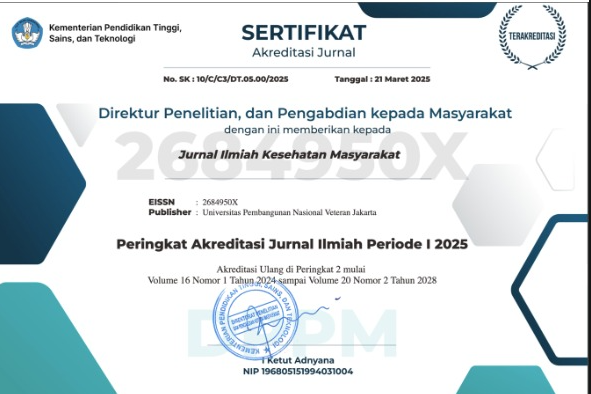Hubungan Karakteristik Sosio-Demografi dengan Kejadian Persalinan Prematur di Rsud Cilegon
Abstract
Abstrak
Latar Belakang: Persalinan prematur merupakan salah satu tantangan penting yang menghambat penurunan angka kematian neonatal sejalan dengan target Tujuan Pembangunan Berkelanjutan (SDGs) 2030. Pada tahun 2015, sekitar 1 juta bayi di seluruh dunia meninggal karena komplikasi persalinan prematur. Indonesia sendiri menempati posisi ke-9 di dunia dengan angka kejadian persalinan prematur sebesar 15,5 bayi per 100 kelahiran hidup. Morbiditas bayi prematur berpengaruh secara fisik hingga tahap perkembangan selanjutnya dan menjadi beban psikologis dan finansial bagi bayi, ibu dan keluarga. Salah satu faktor yang diduga berhubungan dengan persalinan prematur adalah karakteristik sosial demografi yang meliputi usia ibu, latar belakang pendidikan ibu, dan status pekerjaan ibu. Penelitian ini bertujuan untuk mengetahui hubungan antara karakteristik sosio-demografis dengan kejadian persalinan prematur di RSUD Cilegon.
Metode: Desain penelitian adalah studi kasus-kontrol dengan menggunakan data sekunder dari rekam medis RSUD Cilegon periode Januari 2015 sampai Juni 2016. Sampel kasus dipilih secara total sampling, sedangkan sampel kontrol dipilih secara simple random sampling dan mencocokkan jumlah sampel kontrol berdasarkan jumlah kasus per sampel per bulan. Metode analisis yang digunakan adalah analisis bivariat dengan uji chi-square, menilai odds ratio dan interval kepercayaan.
Hasil: Analisis bivariat menghasilkan OR 1,44 (95% CI: 0,68-3,03) dengan p-value 0,34 pada ibu usia > 35 tahun, OR 1,76 (95% CI: 0,68-4,55) dengan p-value 0,24 pada ibu hamil wanita berlatar belakang pendidikan SD/sederajat, dan OR sebesar 0,72 (95% CI: 0,30 -1,72) dengan p-value 0,42 pada wanita hamil yang bekerja.
Kesimpulan: Karakteristik sosiodemografi tidak berhubungan dengan persalinan prematur.
Kata kunci: Persalinan prematur, Karakteristik sosio-demografi, Studi kasus-kontrol, Cilegon
Abstract
Background: The premature delivery is one of crucial challenges which hinders the reduction neonatal mortality aligned with the 2030 Sustainable Development Goals (SDGs) target. In 2015, around 1 million babies worldwide died due to complications of premature labor. Indonesia itself occupies the 9th position in the world with the incidence of premature birth of 15.5 babies per 100 live births. Morbidity of premature babies affects physically until the next stage of development and becomes a psychological and financial burden for the baby, mother and family. One of factors thought to be associated with prematur birth is socio-demographic characteristics which includes maternal age, educational background of mother, and working status of mother. The aim of this study was to determine the relationship between socio-demographic characteristics and premature delivery at RSUD Cilegon.
Methods: The research design was a case-control study using secondary data from the medical records of RSUD Cilegon for the period January 2015 to June 2016. The case sample was selected by total sampling, while the control sample was selected by simple random sampling and matched the number of control samples based on the number of cases per sample by month. The analytical method was bivariate analysis with the chi-square test, assessing odds ratios and confidence intervals.
Result: The bivariate analysis yielded OR of 1.44 (95% CI: 0.68-3.03) with p-value 0.34 in maternal age > 35 years old, OR of 1.76 (95% CI: 0.68 -4.55) with p-value 0.24 in pregnant women who was elementary school/equivalent for educational background, and OR of 0.72 (95% CI: 0.30 -1.72) with p-value 0.42 in pregnant women who was working.
Conclusion: Sociodemographic characteristics were not associated with premature delivery.
Keywords: Premature delivery, Socio-demographic characteristics, Case-control studies, Cilegon
References
Agustina R, Dartanto T, Sitompul R, Susiloretni KA, Suparmi, Achadi EL, et al. Universal health coverage in Indonesia: concept, progress, and challenges. Lancet. 2019;393(10166):75–102.
United Nations. The sustainable development goals report 2019. United Nations Publ issued by Dep Econ Soc Aff [Internet]. 2019;64. Available from: https://undocs.org/E/2019/68
Kruk ME, Gage AD, Arsenault C, Jordan K, Leslie HH, Roder-DeWan S, et al. High-quality health systems in the Sustainable Development Goals era: time for a revolution. Lancet Glob Heal. 2018;6(11):e1196–252.
McArthur JW, Rasmussen K, Yamey G. How many lives are at stake? Assessing 2030 sustainable development goal trajectories for maternal and child health. BMJ [Internet]. 2018;360(February):1–9. Available from: http://dx.doi.org/doi:10.1136/bmj.k373
WHO. Preterm birth: Key facts. World Heal Organ. 2018;2015(February):1–5.
Smid MC, Stringer EM, Stringer JSA. A Worldwide Epidemic: The Problem and Challenges of Preterm Birth in Low- and Middle-Income Countries. Am J Perinatol. 2016;33(3):276–89.
Liu L, Oza S, Hogan D, Chu Y, Perin J, Zhu J, et al. Global, regional, and national causes of under-5 mortality in 2000–15: an updated systematic analysis with implications for the Sustainable Development Goals. Lancet [Internet]. 2016;388(10063):3027–35. Available from: http://dx.doi.org/10.1016/S0140-6736(16)31593-8
Breslin N, Gyamfi-Bannerman C. Current Preterm Birth Prevention Strategies. Clin Perinatol. 2020;47(4):705–17.
Kemenkes RI. Hasil Riset Kesehatan Dasar Tahun 2018. Kementrian Kesehat RI. 2018;53(9):1689–99.
Sari IM, Adisasmita AC, Prasetyo S, Amelia D, Purnamasari R. Effect of premature rupture of membranes on preterm labor: a case-control study in Cilegon, Indonesia. Epidemiol Health. 2020;42:1–6.
Sungkar A, Fattah ANA, Surya R, Santoso BI, Zalud I. High preterm birth at cipto mangunkusumo hospital as a national referral hospital in Indonesia. Med J Indones. 2017;26(3):198–203.
Maqfiro SNA, Fajrin I. Riwayat Komplikasi Maternal terhadap Insiden Kelahiran Prematur di RSUD Dr. H. Chadan Boesoirie Ternate. J Kesehat Terpadu (Integrated Heal Journal). 2020;11(2):52–7.
BAPPENAS. Emerging findings for reaching the targets. 2019;
Limão N. 국회선진화법’ 에 관한 보론No Title’. 입법학연구. 2016;제13집 1호(May):31–48.
Kim SH, Kim YM, Sung JH, Choi SJ, Oh SY, Roh CR. The effects of birth order on neonatal outcomes in early-preterm, late-preterm and term twin infants*. J Matern Neonatal Med [Internet]. 2020;33(12):1980–7. Available from: https://doi.org/10.1080/14767058.2018.1534954
Practice R, Number B. P R AC T I C E Management of Preterm Labor. 2016;128(4):155–64.
Oskovi Kaplan ZA, Ozgu-Erdinc AS. Prediction of Preterm Birth: Maternal Characteristics, Ultrasound Markers, and Biomarkers: An Updated Overview. J Pregnancy. 2018;2018.
Hanretty K. Multiple pregnancy and other antenatal complications. In: Hanretty K, editor. Obstetric Illustrated. 6th ed. London: Churchill Livingstone; 2003. p. 204–6.
Soltani M, Tabatabaee HR, Saeidinejat S, Eslahi M, Yaghoobi H, Mazloumi E, et al. Assessing the risk factors before pregnancy of preterm births in Iran: A population-based case-control study. BMC Pregnancy Childbirth. 2019;19(1):1–8.
Adisasmita A, Smith C V., El-Mohandes AAE, Deviany PE, Ryon JJ, Kiely M, et al. Maternal Characteristics and Clinical Diagnoses Influence Obstetrical Outcomes in Indonesia. Matern Child Health J [Internet]. 2015;19(7):1624–33. Available from: http://dx.doi.org/10.1007/s10995-015-1673-6
Newman RB, Goldenberg RL, Moawad AH, Iams JD, Meis PJ, Das A, et al. Occupational fatigue and preterm premature rupture of membranes. Am J Obstet Gynecol. 2001;184(3):438–46.
Lawson CC, Whelan EA, Hibert EN, Grajewski B, Spiegelman D, Rich-Edwards JW. Occupational factors and risk of preterm birth in nurses. Am J Obstet Gynecol. 2009;200(1):51.e1-51.e8.









.jpg)








